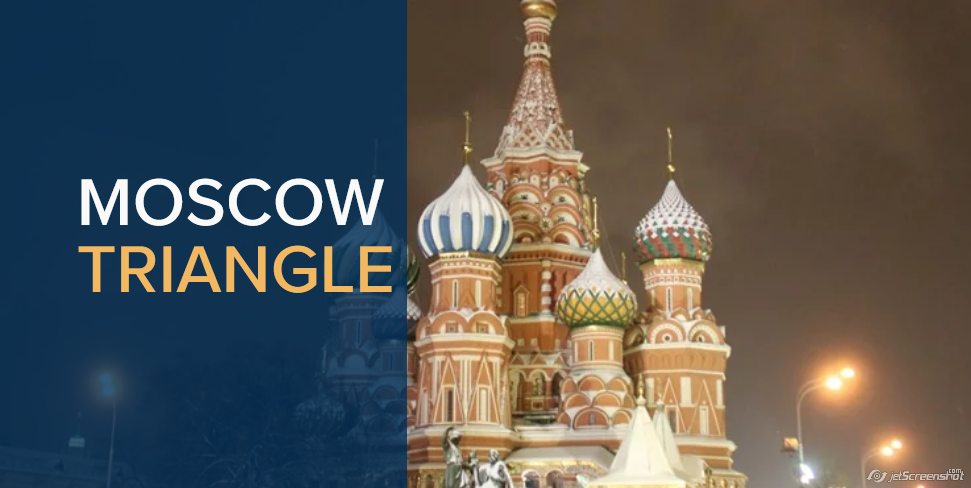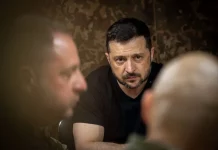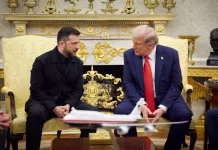
By Anton Shekhovtsov, for CEPA
Relations between various Russian actors and European far-right parties have been the focus of many discussions in the mainstream media and expert publications in recent years. There are several main explanations for this.
First, concerns about Russian actors’ cooperation with the European far right are part of more general concerns about Russia’s interference in the political and, in particular, the electoral processes in the West, especially in the wake of Moscow’s interference in the 2016 U.S. presidential elections.
Second, following Russia’s annexation of the Ukrainian Autonomous Republic of Crimea and invasion of Eastern Ukraine, the Kremlin launched an unprecedented disinformation campaign against the West, often using European far-right forces as amplifiers of the Kremlin propaganda.
Third, mainstream supporters of the Western sanctions imposed on Putin’s Russia for its aggression against Ukraine worry that the existing European consensus about the need for the sanctions may be shaken by the ascension to power of far-right politicians who not only criticized the sanctions but also promised to lift them.
Fourth, there is an understanding in the Western liberal expert circles that the Kremlin is waging a political war against the West, and its apparent support for the anti-EU, anti-establishment, and generally ideologically disruptive far-right parties is considered as part of anti-Western political warfare.
Finally, some Western leaders and opinion-makers tend to avoid honest discussions about the sources of the rise of the European far right and conveniently try to lay all the blame for the illiberal developments and shortcomings of democracy in their home countries, as well as their own political failures, on Putin’s authoritarian and aggressive regime.
Outside of these concerns, fears, and agendas, relations between various Russian actors and European far-right parties appear to be a complex phenomenon, in which nuance is as important as patterns. This article aims to disentangle this confusing phenomenon by providing a brief insight into its development and current state of affairs.
One may justifiably assume that the story about Russia and the European far right is a dual story as it involves two sides and their unique views on, and approaches to, one another. However, I will argue that this story has a third important element (the “Third Party”), the existence of which should become evident from the discussion of the first two, the European far right and Russia.
Thinking about the European far right, it is crucial to resist temptation to project a false paradox: how is it possible that the European far right support Russia, if historically the far right—for example, the Third Reich—always aimed at crushing Russia? It is true that fascist regimes in power (Hitler’s Germany or Mussolini’s Italy) aspired to colonize the Soviet Union and fought an all-out war against it. It is also true that fascism and communism were sworn ideological enemies, as they imagined two conflicting modernities—one centered on the dictatorship of the nation (or race), the other on the internationalist dictatorship of the proletariat. However, the totalitarian nature of both fascism and communism provided a limited yet still viable space for ideological convergence and, indeed, this convergence existed in some circles in the late 1920s and early 1930s in the form of National Bolshevism, an ideology that combined ultranationalist approaches to politics and commitment to class struggle. Moreover, fascism and communism—as two competing modernities—were alternatives to yet another modernity, namely liberalism, and, at times, would unite against this common enemy despite the clear differences between them. All these ideological concurrences and, sometimes, practical agreements provided a platform on which European fascists and Soviet communists could stand united against Western liberal capitalism.
However, National Bolshevism was far from a dominant ideological strand among the European far right in the interwar period, but the situation changed after the Second World War. The West European far-right milieu—in addition to having been extremely weakened by the military defeat of the Axis powers—was split during the Cold War between pro-American and pro-Soviet forces or, more accurately, between hardcore anti-communist ultranationalists and anti-American far-right politicians. The latter would be willing to cooperate with Soviet Russia, as they saw it as a lesser evil in comparison to the United States and an illiberal ally in their fight against the liberal mainstream elites in their societies.
The second side of the story, Russia (or Soviet Russia, if looking at the historical aspect), was ambiguous in its relations with the European far right too. On the one hand, Soviet communism officially considered fascism as a “terrorist dictatorship of the most reactionary, most chauvinistic and most imperialist elements of finance capital” and tolerated no ideological convergence with the far right. But on the other hand, Soviet authorities and, during the Cold War, Soviet security and intelligence agencies never missed a chance to directly or indirectly use the far right to undermine liberal-democratic forces in Western Europe or discredit entire West European nations, for example, by pointing to anti-Semitic incidents covertly orchestrated by the Soviet intelligence agencies.
This brief overview of the historical relations between the European far right and Soviet Russia allows us to draw two major conclusions. First, these relations were underpinned not by one factor, but rather by a complex mixture of various considerations – ideological, tactical, pragmatic, etc. Second, the liberal-democratic West that stood against the far right and Soviet Russia was a necessary third element in the relations between the former two: it was the existence of this “Third Party”—or the perceived threats it posed to any of the other two elements (or to both of them)—that justified and provided rationale for various types of cooperation between Russian actors and the European far right.
After the collapse of the Soviet Union, the relations between post-Soviet Russia during Yeltsin’s years and Putin’s first presidential term and the “Third Party” shaped relations between Russia and the European far right, or—to be more precise—the absence of such relations. Doubtlessly, Russian far-right politicians and ideologues such as Vladimir Zhirinovsky, Alexander Dugin, or Sergey Baburin built contacts with their European counterparts, for example, leaders of far-right parties and movements such as Jean-Marie Le Pen (National Front), Gerhard Frey (German People’s Union), or Alain de Benoist (French New Right). But these contacts were marginal and were related not to the interests of the Russian state but rather to the political interests of Zhirinovsky, Dugin, or Baburin. Neither Yeltsin nor Putin during their first terms were interested in having anything to do with the European far right: nationally and internationally, they presented Russia as a democratizing state, and had thriving relations with Western nations, including the United States. In other words, Russia and the “Third Party” enjoyed a honey moon, and the Kremlin was probably not even aware of the European far right as a viable political partner.
And those were the Kremlin’s perceptions of the “Third Party” in the period starting from Putin’s second presidential term that gradually “pushed” Moscow to build stronger connections with European radical right-wing parties. In the eyes of the Kremlin, in the period between 2004 and 2012, Western nations were involved in the activities that it considered to be a betrayal of Russia by the “Third Party.” A series of “color revolutions” in the post-Soviet space in 2003-2005 (Georgia, Ukraine, and Kyrgyzstan) was the first perceived act of perfidy. Especially after the “Orange Revolution” in Ukraine, Moscow increasingly started to believe that not only the West in general and the United States in particular were directly involved in orchestrating those “color revolutions” but also that the “Third Party” was actually aiming at a regime change in Russia itself. The Kremlin responded to the “color revolutions” by mainstreaming anti-Westernism and anti-Americanism that had been largely confined previously to the fringes of Russian politics. Moreover, Russian pro-regime organizations started to engage with European far-right politicians and establish clusters of cooperation, for example, in the area of politically-biased international election observation (which would later be used, for example, for the Kremlin’s attempts to legitimize the annexation of Crimea).
The second perceived act of perfidy was the Western reaction to the Russian invasion of Georgia in August 2008. Moscow considered the 5-day Russo-Georgian war as a peace enforcement operation aimed at preventing Georgia from taking control over the separatist regions of South Ossetia and Abkhazia, which Russia eventually occupied as a result of the war. Although some Western nations adopted a pro-Kremlin or a neutral position, the majority would criticize Russia for violating Georgia’s territorial integrity. The Kremlin considered its failure to convince the “Third Party” in the appropriateness of the Russian actions as its defeat in the “information war” with the West. The realization of the defeat of the Kremlin’s media had two consequences. First, Moscow discovered that if it could not find friendly voices among mainstream European politicians, it could rely on anti-establishment politicians who were glad to provide their commentary to the Russian major media – an opportunity denied to them in their home countries. Second, Moscow decided to reimagine its approach to pushing its messages through the state-controlled international media: it partially strayed from eulogizing Putin’s Russia (Russian soft power was considered deficient) and prioritised exposing the alleged failings of the West: European radical right-wing populists became ideal commentators on these issues.
The third perceived act of perfidy was a series of developments in 2011-2012. First, very much like the “color revolutions” in the post-Soviet space, the Arab Spring was considered by Moscow as having been orchestrated by the West in its global pro-democracy quest and, consequently, as a clear threat to Russia. Second, Moscow’s concerns about the Arab Spring immediately overlapped with the concerns about the anti-Putin protests in Russia in 2011-2012 which, again, were thought to have been inspired if not directed by the West. Third, the United States adopted the so-called Magnitsky Act, i.e. the first significant sanctions against Russian officials. Putin’s regime considered all these developments as yet another betrayal of Russia by the “Third Party” and intensified its cooperation with the European far right in various areas.
After the annexation of Crimea and invasion of Eastern Ukraine, and the subsequent imposition of Western sanctions against Putin’s Russia, the latter further deepened its collaboration with a number of European radical right-wing parties, most notably the French National Front, Austrian Freedom Party, Italian Northern League, Alternative for Germany, Bulgarian “Attack,” and some others. Various Russian actors provided support (political, media, and less frequently, financial) for the European far right; in return, they enlisted right-wing populists’ public support for all the Kremlin’s foreign adventures and domestic repressions, as well as accepted whole-hearted assurances that the far right would lift the “anti-Russian sanctions” once they came to power.
The relations between Russian actors and European radical right-wing populists have never been easy, which is a result of conflicting attitudes and developments. Let us consider how the two sides of this relationship look at each other, and how it is related to the “Third Party.”
In the Russian establishment, there are three major attitudes towards the European far right. The first attitude is the ideological willingness to cooperate with radical right-wing populists. Since Putin’s regime is predominantly non-ideological in nature, this attitude is advanced by a small national-conservative group on the periphery of the regime; this group promotes Russia as a sworn ideological enemy of global liberalism (or liberal globalism) and sees in the European far right a genuine ally in its anti-democratic struggle. The second attitude is underpinned by pragmatic and tactical considerations – and the group that adopts this attitude is by far the largest inside the Russian establishment: cooperation with the far right is contextual and guided by ad hoc criteria. Right-wing populists are perhaps needed today but may not be needed tomorrow. The third attitude—while not being liberal—is nevertheless negative towards the far right; people who share this attitude consider it almost an insult for Russia to cooperate with European radical right-wing populists as they see in them ideological descendants of the 20th century fascists who killed Russian people. The group that advances this attitude is arguably even smaller than the group that adopts the first one.
These three attitudes directly correlate with Moscow’s approaches to the “Third Party.” The first group is unwilling to have any good relations with the Western liberal-democratic mainstream. The second group prefers to cooperate with the Western establishment but it will not hesitate to try to subvert it—in particular through the support of the far right—if it feels that the “Third Party” is plotting against Putin’s regime or is too difficult to corrupt. The third group will not cooperate with the far right even if Moscow’s relations with Western capitals hit the bottom.
The classification of the attitudes towards Russia on the part of the European far right is even more complex. By far the largest group of European radical right-wing parties in opposition espouses pro-Kremlin views; in Putin’s Russia, they see a model of a right-wing authoritarian state that successfully challenges the liberal-democratic consensus and American global hegemony. Far-right parties in Austria, Belgium, Bulgaria, Czech Republic, France, Germany, Greece, Italy, Serbia, Slovakia, and the UK predominantly share this particular attitude. The second, much smaller group comprises those far-right parties that—to one degree or another—distrust Russia for historical reasons, and here one can mention far-right parties in the Baltic States, Finland, Poland, Romania, and Ukraine. Far-right parties that are ambivalent towards Russia represent yet another small group: right-wing populists in Denmark, Netherlands, Norway, Spain, and Sweden may agree with Putin’s regime on one issue and disagree on another.
Moreover, the situation with the right-wing populists’ attitudes towards Moscow gets more complicated if one considers a political competition between different right-wing parties in one and the same country. Hungary is the case in point here: Jobbik was known for its far-right and openly pro-Kremlin views, but as the ruling party center-right Fidesz led by Prime Minister Viktor Orbán gradually shifted in the far-right direction, “stealing” votes from Jobbik, the latter shifted to the center-right positions and largely abandoned its pro-Kremlin stances, while Orbán’s far-right regime deepened its cooperation with the Kremlin for pragmatic reasons. Yet another complication is shaped by the attitudes towards the “Ukrainian question:” some members of the youth wings of European far-right parties are clearly fascinated by the participation of Ukrainian far-right groups in the armed resistance against Russian aggression and tend to support Ukraine, rather than Russia, in this struggle, which exerts particular impact on the geopolitical worldview of the “adults” in the party.
Right-wing populists’ approaches towards the “Third Party” are important too. Far-right parties in Denmark, Norway, and Sweden may be unwilling to voice support for the Kremlin, because they hope to enter government coalitions with liberal-democratic forces that are critical of Putin’s Russia. But when far-right parties enter government coalitions, for example, in Austria, Bulgaria, and Italy, they may be unwilling—no matter how sincere their oaths of friendship with Mother Russia were while in opposition—to challenge the consensus on Russia shaped by the critical approaches of the “Third Party” because relationships with Moscow fade into insignificance.
The dominant “Third Party,” namely the liberal-democratic establishment, remains a significant point of reference both for Putin’s Russia and the European far right, and their subjective interpretations of its intentions and behaviour will continue to shape their approaches to each other, especially when we are talking about the two prevalent attitudes in their camps.
By Anton Shekhovtsov, for CEPA
Europe’s Edge is an online journal covering crucial topics in the transatlantic policy debate. All opinions are those of the author and do not necessarily represent the position or views of the institutions they represent or the Center for European Policy Analysis.
A version of this article first appeared in Internationale Politik, No. 2, 2020.




